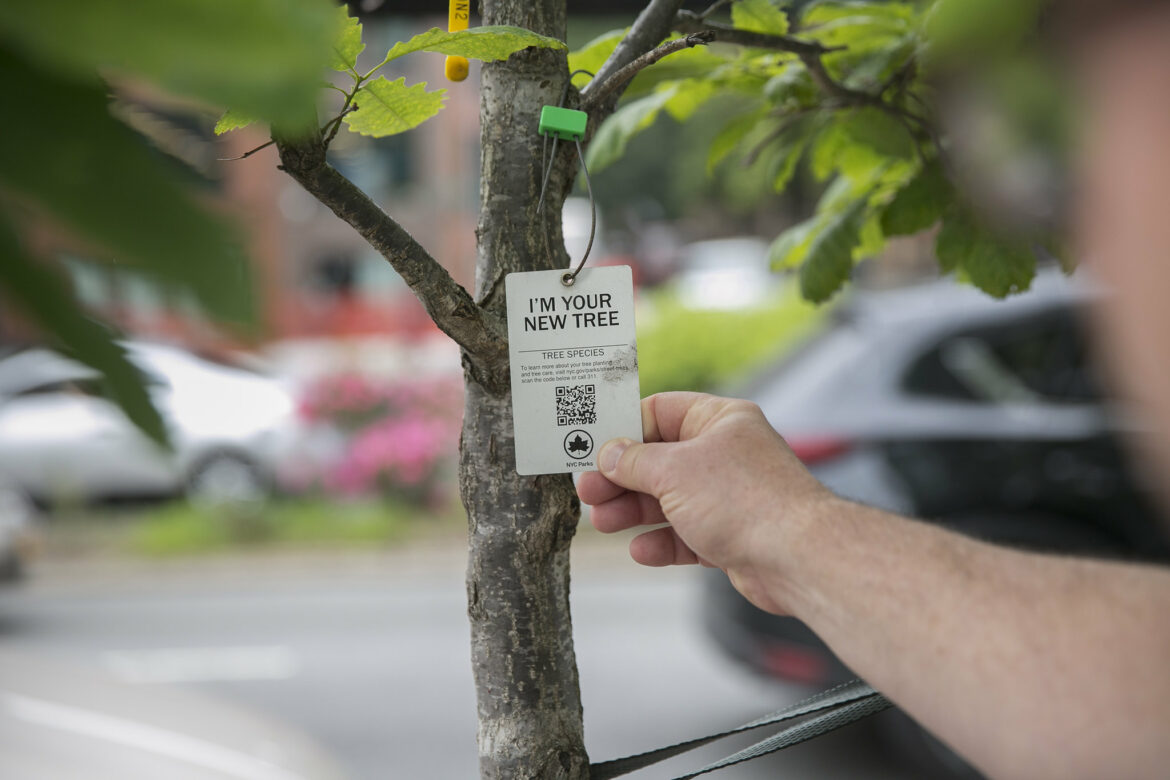Species like oaks and sweetgums, which make up a large share of the city’s treescape, emit a chemical that generates a toxic gas when it comes into contact with fossil fuel pollution, researchers say.

Caroline Willis/Mayoral Photography Office
Home to a myriad of cars and buildings that run on fossil fuels and generate more than half of the state’s greenhouse gas emissions, pollution in New York City can feel overpowering.
While planting trees helps curb pollution by absorbing these gasses, certain species can actually make it worse, a recent study published in the Environmental Science & Technology journal reveals.
Species like oaks and sweetgums emit a chemical called isoprene that is harmless to humans on its own. But when it interacts with pollutants generated from fossil fuel combustion, they create a toxic gas called ground-level ozone that can irritate the throat, inflame airways and increase the frequency of asthma attacks.
“What we plant, from an air quality perspective, is really only a problem because of the amount of fossil fuels that we burn in New York City,” said Andrew Reinmann, an ecologist and CUNY professor who helped author the report.
And that is especially worrisome when the Big Apple’s landscape is also populated by a sizable portion of oaks and sweetgums.
Of the five million trees that make up the city’s parks and forests, more than half are oaks (37 percent) and sweetgums (17 percent), according to the study. When it comes to the over 666,000 street trees that line many sidewalks, that number is a lot less. Only 18 percent are oaks, and sweetgums comprise an insignificant amount left out by the study.
But if the city maintains its current tree planting patterns, isoprene production in Manhattan in coming decades will increase by about 140 percent, the report warns. Emissions of isoprene tend to increase exponentially with heat, so ozone levels are also projected to go up as much as 30 percent on hot summer days.
To come up with these figures, a team of scientists looked at the New York City Park Department’s tree census from 2016 to 2018 and combined it with satellite imagery of the city’s tree canopy. They also used a model created by the study’s lead and postdoctoral researcher at Stony Brook University, Dandan Wei, to uncover how trees interact with vehicle exhaust and building emissions.
To curb pollution, city officials need to be very strategic about what kinds of trees they plant, Wei says, “especially when we are pushing for new trees.”
The Parks Department has been on a quest to plant 1 million new trees in the Big Apple. And last year all five borough presidents began drumming up support to follow through with the commitment by 2030.
“What we really need to do is focus on reducing [pollution] from human activities,” Wei said. “But until then, we need to understand what are the best tree species to plant in terms of air quality.”
In the past, sweetgum and oaks, in their many variations, were a favorite pick for New York City’s treescape because they are native to many forests across the northeast. There are nearly 20,600 sweetgums in the city’s treescape, according to the Parks Department’s Tree Map. In the oak category, the pin oak variation is a popular pick, with nearly 75,000 spread throughout the boroughs.
But when it comes to selectively picking trees to avoid ground level ozone, the Parks Department told City Limits that one study alone will not change their overall planting strategy. The agency said it is committed to providing a “healthy and successful urban forest” and noted that oaks and sweetgums comprise a small amount of the overall tree population: 6 percent and 2.3 percent, respectively.
“Thanks to our consistent work with local nurseries to procure unique and diverse trees, we now plant from a palate of over 130 different species of trees, up from only 29 species twenty years ago”, Deputy Commissioner for Environment and Planning at NYC Parks, Jennifer Greenfeld, said in an emailed statement.
“We aim to continue planting and growing a diverse population of trees across the city that can tolerate all the challenges that the urban landscape provides,” she added.
Still, picking the right kind of tree to plant can be crucial at a time when New York lags behind on curbing fossil fuel induced pollution, experts say.
The pace at which New York has reduced air pollution’s most prominent gasses, nitrogen oxides, has been extremely slow, according to the study. At current rates of 2 percent to 5 percent a year, it would take 30 to 80 years for the city to cut back on these gasses to a point where emissions from trees no longer play a role in ozone formation.
The ultimate solution is to invest in electrification and cleaner sources of energy, Reinmann says. New York, however, is still very much dependent on fossil fuels as only 28 percent of the state’s electricity is generated by renewable sources.
“If we were able to get to a point where we’ve largely electrified our automobile fleet, and we greatly reduced nitrogen oxide emissions from power plants and other forms of burning fossil fuels in the city, then it wouldn’t really matter what trees we planted,” Reinmann said.
To reach the reporter behind this story, contact Mariana@citylimits.org. To reach the editor, contact Jeanmarie@citylimits.org
Want to republish this story? Find City Limits’ reprint policy here.









2 thoughts on “Planting Certain Trees Can Make NYC’s Polluted Air Worse, New Study Finds”
I seem to recall Uncle Bonzo saying something like this. HE never lied, did he?
“Still, picking the right kind of tree to plant can be crucial…”
And those tree are??? Name names, journalist.